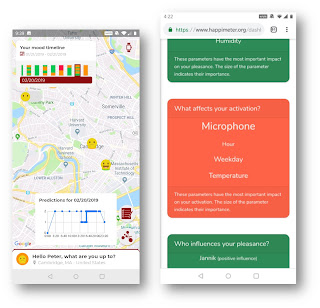Navigating Human Emotions with the “Social Compass” - Peter Gloor

Navigating human emotions can be extremely difficult. Just ask politicians such as former US Vice President Joe Biden who was hit by a firestorm of protests by getting too touchy-feely with supporters, or US senator Elizabeth Warren who ran into unexpected criticism for claiming Native American ancestry. While trying to behave rationally, they become victims of their emotions.
In an interview Linus Torvalds said “I absolutely detest modern "social media"—Twitter, Facebook, Instagram. It's a disease. It seems to encourage bad behavior.”…. “When you're not talking to somebody face to face, and you miss all the normal social cues, it's easy to miss humor and sarcasm”…”The whole "liking" and "sharing" model is just garbage. “ In our research we are developing a “Social Compass” that helps individuals navigate their emotional world, just like Google helps a person to navigate the relational world of facts and science. Just like Google Maps shows where somebody is in the physical world, where they can go, and where the bottlenecks and traffic jams are, the “Social Compass” helps individuals navigate the social landscape of their emotions and the emotions of others. It tells individuals how others see them, and what they can do to be happier, and more collaborative and productive. It gives an individual a “virtual mirror” of their own communication behavior, and shows them how others see them.
The “Social Compass” is calculated based on an individual’s communication behavior, by analyzing the communication archives arising from the individual’s interaction with others (see picture below).
The “Social Compass” takes as input communication signals, and through machine learning and AI gives recommendations for more happiness, better collaboration and higher productivity. It analyzes body signals measured through smartwatches, organizational communication from E-Mail or chat like Slack or Skype, and online social media from Twitter, Reddit, or YouTube. From these three types of communication archives, it calculates the seven honest signals of collaboration (strong leadership, balanced contribution, rotating leadership, responsiveness, honest sentiment, shared context, social capital) and the emotions of the person (joy, sadness, fear, anger). These honest signals and emotions are used as input for machine learning, to calculate the FFI personality characteristics (openness, conscientiousness, extroversion, agreeability, neuroticism), the Schwartz ethical values (openness - conservation, self-enhancement – self-transcendence) and moral foundations (care, fairness, loyalty, authority, sanctity).
The Social Compass presents this information to the user in two ways. As a Virtual Mirror, it shows each person in an anonymized way how they are doing compared to their peers. In addition, it also gives users “social driving directions” similar to Google Maps.
The Virtual Mirror shows the seven honest signals of collaboration for each individual, calculated from e-mail or from body signals. It respects individual privacy, by only showing individual information to the individual and aggregating other people’s values to group averages. The picture below shows the individual dashboard of the e-mail based Virtual Mirror, computed from the e-mail archive of the individual.
The Social Compass also allows an individual to track the location of their emotional experiences such as how happy the individual has been at a particular day, and where on the map that happiness was measured on that day. The picture below shows a screenshot of my Happimeter Android phone app on February 20, 2019. In addition, the social compass also shows which variables have influenced my happiness, and who has positively or negatively influenced it. Finally, the same virtual mirroring information can also be shown on the Happimeter smartwatch, this function is also used to improve the machine learning accuracy of the emotion prediction of the wearer of the smartwatch.
Recommended Articles
Seeing is Believing.
Many software demonstrations end up being generic product promotions. We take the time to understand your specific needs before preparing a customised demonstration that provides you with: • Case studies of how organisations similar to yours have used our technology to improve related issues. • Scientific evidence published in major journals to back-up our statements. Please complete this form and a platform expert will be in touch shortly to take you through a demo of our technology with evidence relevant to your needs.









